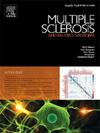Allopurinol use and risk of multiple sclerosis
IF 2.9
3区 医学
Q2 CLINICAL NEUROLOGY
引用次数: 0
Abstract
Background
Low uric acid levels have been observed in patients with multiple sclerosis (MS). As allopurinol is commonly used to lower uric acid in gout patients, this study examined allopurinol use in individuals with MS during the five years before diagnosis, compared to a matched control group.
Methods
This nationwide case-control study used Danish health registry data. 9,063 individuals diagnosed with MS between 2008 and 2023 were included on the day of MS diagnosis, while 90,630 controls, were matched from the general population. Controls were matched on age, gender, place of residence, and inclusion date. Allopurinol prescriptions were tracked annually for five years prior to the inclusion date. The primary outcome was the odds ratio of allopurinol use in MS patients compared to controls, analyzed using conditional logistic regression.
Results
In the five years prior to the MS diagnosis or matching date for controls, allopurinol use was consistently lower in MS cases. In total, 0.30% (n = 27) of MS cases had at least one allopurinol prescription, compared to 0.62% (n = 558) of controls, corresponding to an odds ratio of 0.48 (95% CI: 0.33–0.71).
Conclusions
Individuals diagnosed with MS had significantly lower allopurinol use in the five years preceding their diagnosis, suggesting an inverse relationship between uric acid levels and MS risk. Reduced uric acid levels may be associated with early MS development, possibly due to its antioxidant properties or metabolic changes. Alternatively, these findings suggest a possible protective effect of allopurinol against MS, warranting further investigation.
求助全文
约1分钟内获得全文
求助全文
来源期刊

Multiple sclerosis and related disorders
CLINICAL NEUROLOGY-
CiteScore
5.80
自引率
20.00%
发文量
814
审稿时长
66 days
期刊介绍:
Multiple Sclerosis is an area of ever expanding research and escalating publications. Multiple Sclerosis and Related Disorders is a wide ranging international journal supported by key researchers from all neuroscience domains that focus on MS and associated disease of the central nervous system. The primary aim of this new journal is the rapid publication of high quality original research in the field. Important secondary aims will be timely updates and editorials on important scientific and clinical care advances, controversies in the field, and invited opinion articles from current thought leaders on topical issues. One section of the journal will focus on teaching, written to enhance the practice of community and academic neurologists involved in the care of MS patients. Summaries of key articles written for a lay audience will be provided as an on-line resource.
A team of four chief editors is supported by leading section editors who will commission and appraise original and review articles concerning: clinical neurology, neuroimaging, neuropathology, neuroepidemiology, therapeutics, genetics / transcriptomics, experimental models, neuroimmunology, biomarkers, neuropsychology, neurorehabilitation, measurement scales, teaching, neuroethics and lay communication.
 求助内容:
求助内容: 应助结果提醒方式:
应助结果提醒方式:


